As it is abundantly clear between this blog and my productivity podcast I love working with productivity systems. I love trying out new apps and techniques and then seeing if they’re worth implementing into my personal life. Throughout the years I’ve had plenty of daily drivers come and go depending on what my needs were for that moment, only to be replaced within something more fitting to what I was looking for. For instance, I used to be big into bullet journalling and for years I never touched anything digital for task management. Fast forward to today and almost everything I use is digital, which I find makes managing tasks for multiple projects much easier rather than having to constantly flip through pages in my journal.
In this post I will be showcasing my (mostly) digital daily drivers I use to get stuff done. From high level planning in Notion, to task management in Todoist, and finally using Analog to triage those tasks. Much like my monthly review, what I use is tailored for me at this moment in my life and might not be the best for for everyone, but I do hope to inspire you to try out these methods and see if they’re a good fit for you. So with further ado, let’s take a look at my daily drivers as of April 2021.
Table of Contents
Notion: A Perfect High Level Manager
As a proud member of the Notion Nation[1]The unofficial name of Notion users out there. I have been using Notion for many years to organize my life. For those of you who may have never heard of Notion, Notion is a flexible easily customizable note and project management app. Notion works using three main features: pages, blocks and databases. Without going too into detail pages are just like they sound like: they’re note pages. Pages are subdivided into blocks that can be anywhere from text blocks, to images. Finally pages can be stored within databases or as subpages to another one. It’s the databases really that set Notion apart from all other note apps out there.
With a database you can add as many columns as needed for sorting your pages, from tags to dates and even custom formula, the ability to sort items in Notion boundless. Furthermore, databases can be displayed in different ways, from simple spreadsheets to kanban boards and even calendars. The database feature is what makes Notion such a powerful tool. Notion itself has its own issues, from speed to unexpected downtime, and no offline support, but those are issues to discuss for another time. Right now we’ll be taking a look at my Notion setup for monthly & weekly planning, along with project management. The rest of this section will be tailored towards the experienced Notion user, so if you’re interested in learning more I suggest diving down to rabbit hole that is Notion YouTube.[2]Warning: Notion YouTube is extremely addicting and can lead to symptoms such as a perpetual desire to redo your set up.
The Goal Hub
Welcome to The Goal Hub, the place where everything happens. The Goal Hub is divided in five main sections: A kanban board of all of my projects.
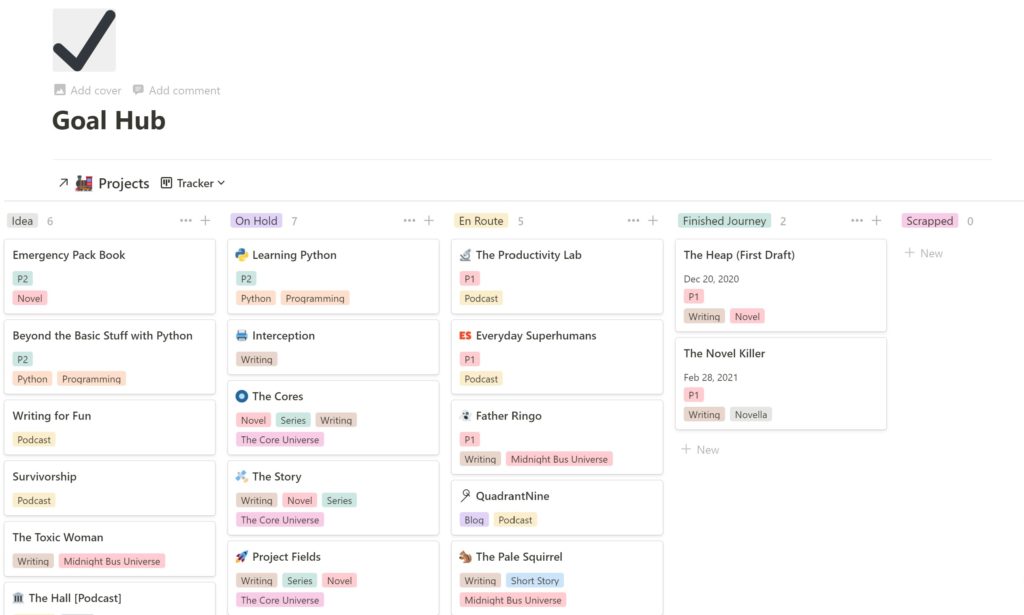
To an overview of all my yearly themes and reviews.

A breakdown of all of my monthly goal pages.

Which of course what a goals without reflecting upon them?[3]More on that in my past post on my monthly review.

And finally a database of all of my high level tasks.
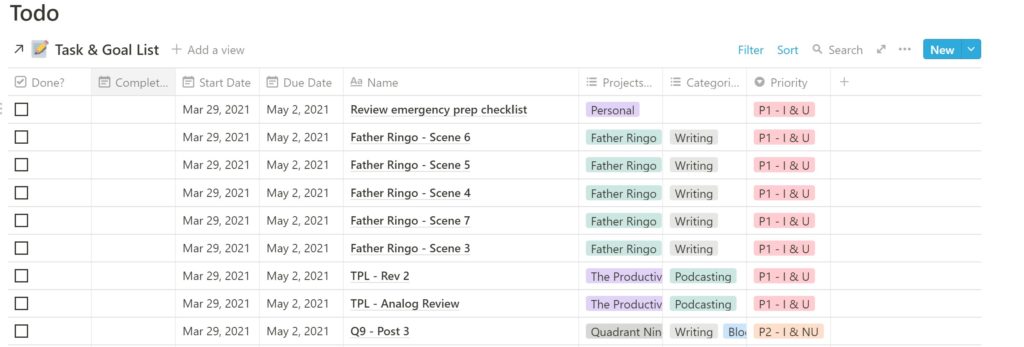
The Goal Hub is where things happen. For the purposes of my daily drivers we’ll only take a look at my monthly goal pages.
Monthly & Weekly Goals
I kind of covered this in my monthly reflection post, so if you’ve read that one this page might look familiar to you. The Monthly Goal Page is broken down into five main sections: my high level tasks, my monthly focus, my monthly goals, my weekly goals, and then a list of the high level tasks completed that month.
High Level Tasks

The High Level Tasks list might look familiar, that’s because it’s an inline database linking to the all encompassing one as shown in the Goal Hub. The view is just simplified and only shows the outstanding tasks within a specified date range.
Side Note: One thing that I do differently is that my “months” are not calendar months. Instead they’re my own system derived from a calendar month, but instead of having each month begin on an arbitrary day, like they do on normal calendars, my months always begin on Mondays and always end on Sundays. I find this system keeps it simple. The way I decide which Monday to begin on and which Sunday I end on is a bit arbitrary itself, but the general rule of thumb is if the week the first day of the month has more days for the upcoming month then that is the first week of the next month, if there are less days then that is the last week of the current month. For example, April 2021 has 4 days within April that fall within the week of April 1st. That means that March 29th is the first day of my April 2021. April 2021 also has more days in the last week of the month than May, which means that May 2nd is the last day of my April 2021.
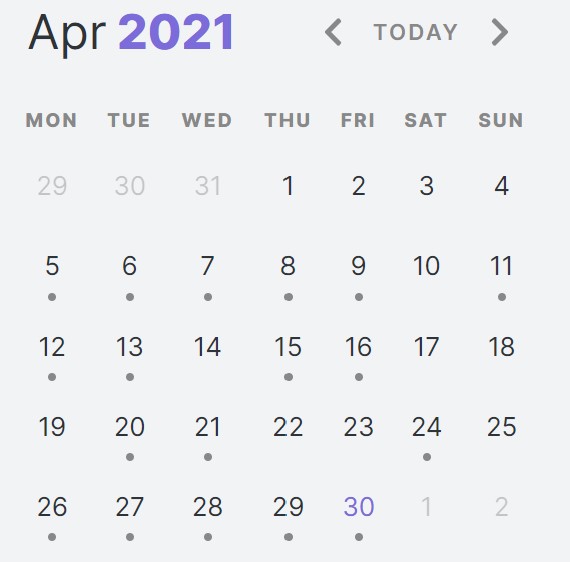
August 2021 is the opposite: the week August 1st falls within has more days from July in it than August, so my first day of August actually begins August 2nd. Same can be said with the last week of August, the week of the last day has more days within September than than August so my actual last day of August is August 29th.
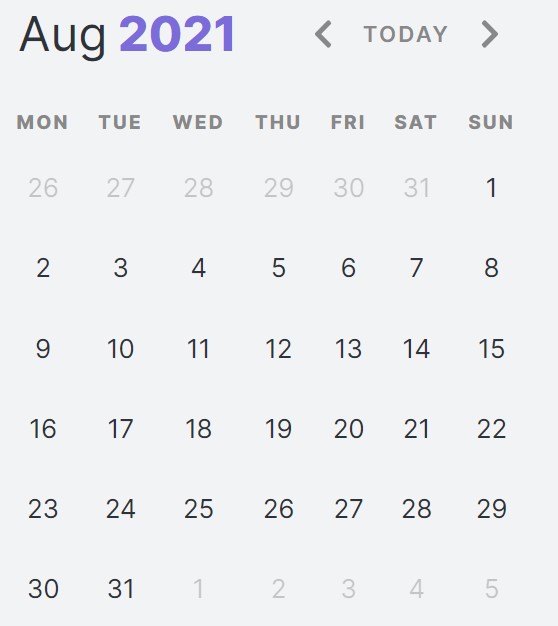
This system works best especially when you think about how most of our lives revolve on what day of the week it is instead of what month it is. I’m sure in most people’s cases nobody cares which day March 1st lies on, they care more about what day of the week it is. Because of that, this system works well with my Weekly Goals (more on those later).
Monthly Focus
Tasks are all fine and dandy, but task would be nothing without some aspiration to strive for. Since my system is designed for my personal life and not professional life, pretty much everything in it has to be inspired by some higher level goal. Each month I sit down and list out 3 to 5 bullet points of things I want to focus on, from that all things flow. Below is a look at my March 2021 Monthly Focus
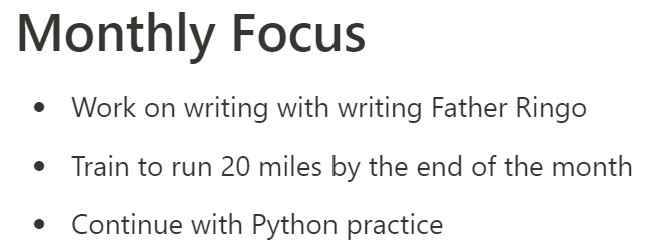
Monthly Goals
Honestly this should be changed to “Monthly Tasks” but I think “Monthly Goals” fits it as well. The Monthly Goal is a list of no more than 5 goals I want to accomplish that month, I choose to pick no more than 5 in order to not overwhelm myself. Anything else I’d like to do but don’t think I have enough time for goes in the “Nice to Do” list. Below are my monthly goals from March 2021, as you can see even with 5 goals I can’t check off all the boxes.
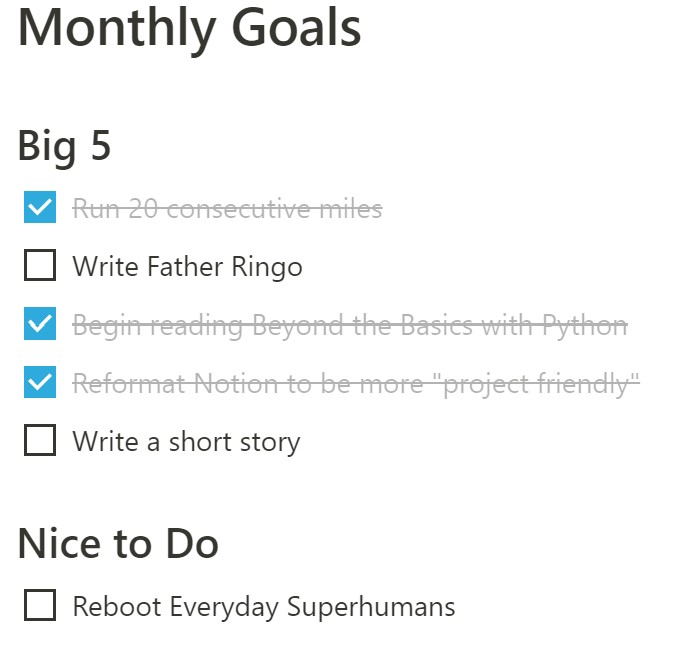
Weekly Goals
Now this is where the action happens. This is as close to “low level tasks” I will get in Notion before moving to Todoist. The Weekly Goals takes from the High Level Tasks and the Monthly Goals and distills them down to my Big 3 goals that week (of course with a Nice To Do section as well if I’m feeling ambitious). This list is the most important list within my Notion. I don’t review it every day, but all my personal tasks (we’ll get to that soon) revolve around this one. Below is the final week of March 2021.
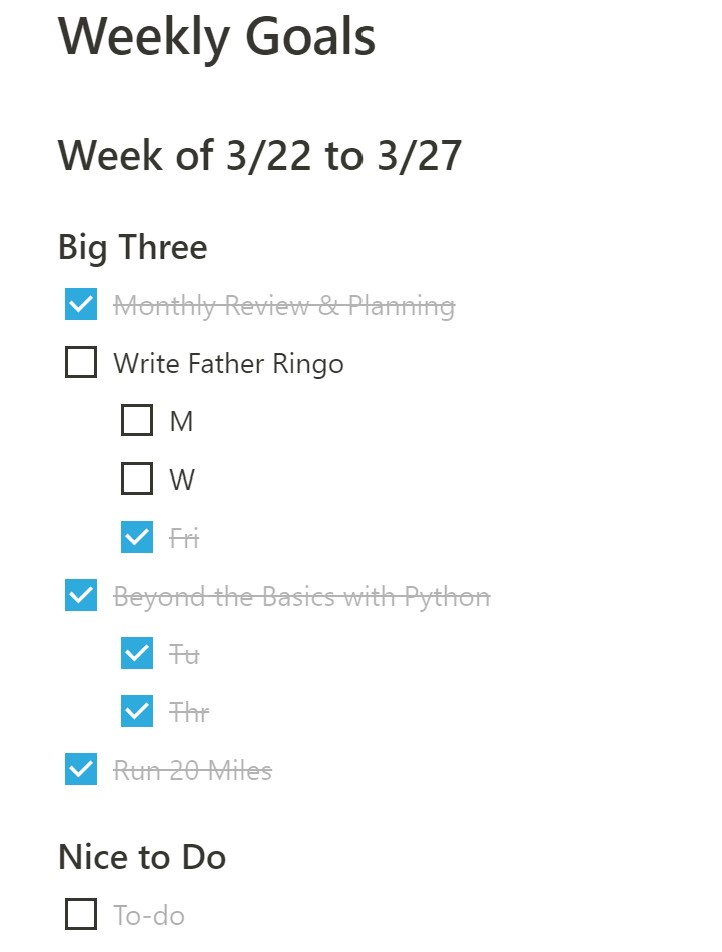
And with that we are done with the high level stuff, next up we get down and dirty with task managers.
Todoist: Love At First Check Box
I’ve written about my love of Todoist before back in 2018 when I first started taking the app seriously, and since then I’ve been a happy supporter ever since. Todoist is task management app that focuses on ease of use while also providing a wide functionality of tools to help you get stuff done. The selling point of Todoist, in my opinion is it’s natural language input. For example if you were to write “Finish Daily Drivers Post today at 5pm” into it it will automatically know what you mean by “today” and “5pm”. Using a few more shorthands in the field such as a hash / pound symbol “#” allows you to assign the project, and using the at symbol “@” allows you to tag it as well.

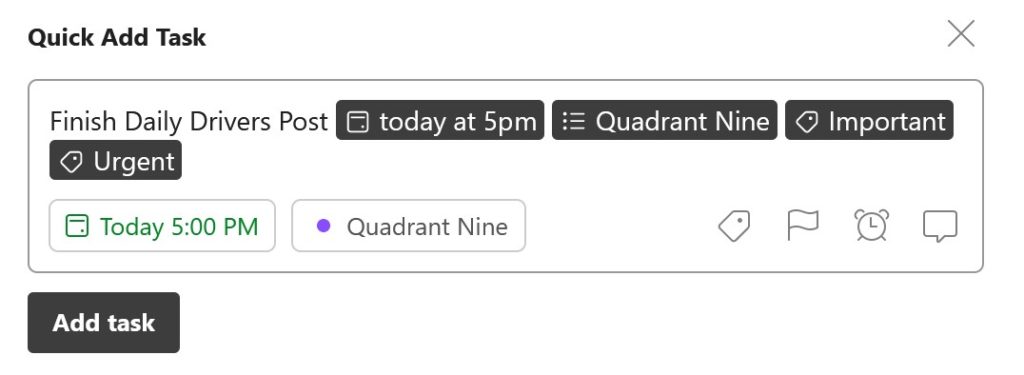
Side Note: There are other shorthands as well such as P1 through P4 which sorts your tasks from highest (P1) to lowest (P4), by default all tasks are given the P4 label. I personally only use P1 plus tags for everything, except for my “Moving the Needle” tasks, but more on those later.
Using a combination of these features allows you to create a plethora of filters. Filters are exactly what they sound like: they allow you to filter your task view based on what ever your preferences are. But perhaps the most important view in Todoist is the default Today view, as shown below. This is my list of tasks too be completed on May 1st.
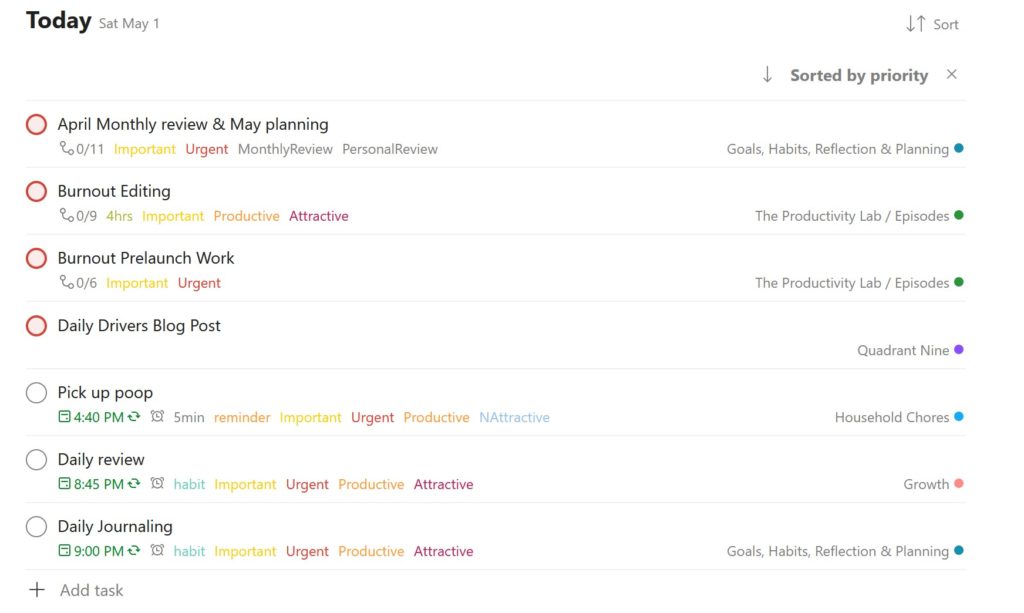
As you can see there are tasks with white circles next to them, and others with red. The white circles are the default P4 priorities, they’re there for just things that should get done but aren’t the most important. Meanwhile the red circles are P1 priorities, which to me means one thing: moving the needle tasks. Moving the needle tasks are the most important tasks to complete for a project, without them the project wouldn’t move forward. So although they might not be the highest priority, they are of the highest importance, which is why I give them the P4 designation so that way they’re the most visible and are moved to the top of the list.
I also use a good number of filters, which deserve a blog post all on their own. Below is a sample of some of my filters, I have a lot but in general I use just the top few in the list shown below.
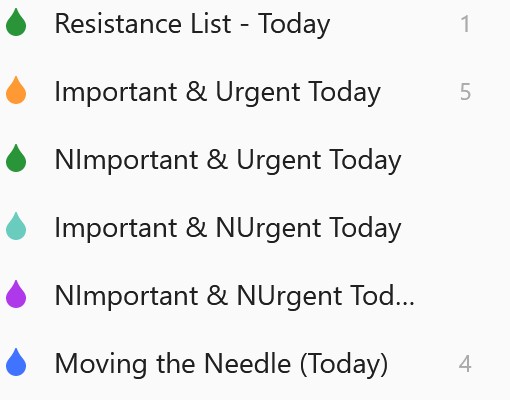
Side Note: Up until April 2021 I was using Todoist for both my personal projects and work, but after years of using Todoist for both aspects of my life and as gap between the two began to narrow after the COVID-19 pandemic I decided to migrate my work tasks to Microsoft Todo. Microsoft Todo, although a daily driver, I decided to exclude it to this post since it’s still a new feature and deserves its own dedicated post in my opinion.
And here we are, at the end of our journey within the digital world. However there is one more stop we must make one more stop in the world of the real, with the final distillation of this system: Analog.
Analog: Triaging Tasks
Analog by UgMonk is the latest edition to my daily drivers, having had arrived their thanks to reviewing it on The Productivity Lab not too long ago. As I mentioned earlier in this post, I abandoned my paper task management systems a while ago, forgoing them for the world of the digital, and for a while the digital systems were just fine until they weren’t.
The problem with having a strictly digital system is that there is virtually an unlimited amount of space you can fill, but as mere mortal being we don’t have an unlimited amount of time we can use. We have to pick and choose what tasks we want to do and when. Take me for example, I used to wake up each morning and see over 20 things to do in Todoist, which is just way to much. Of course I migrated my work tasks to Microsoft Todo, but that didn’t fix the problem it just made the problem split between two task managers. I was getting overwhelmed and my mind couldn’t handle it. This is where Analog came in.
Analog’s system is simple: it’s effectively a well designed note card with no more than 10 lines on it, and if you ask me 10 is more than enough tasks to complete each day. Which is why I divide mine in half: five work tasks and five personal tasks. These five tasks are the five most important things to work on each day. In this manner Analog acts like a triage room for my tasks, with the most important ones getting the most attention. I can complete other tasks within Todoist and Microsoft Todo that are not written down, but if we were to go back to my Notion usage anything not written down onto my Analog card is effectively a “nice to do” task. Below is a look at a recent Analog card, the top tasks are for work and the bottom are my personal tasks. As you can see I didn’t even fill up the whole thing, which is good because that means I have buffer to work with in case something comes up.
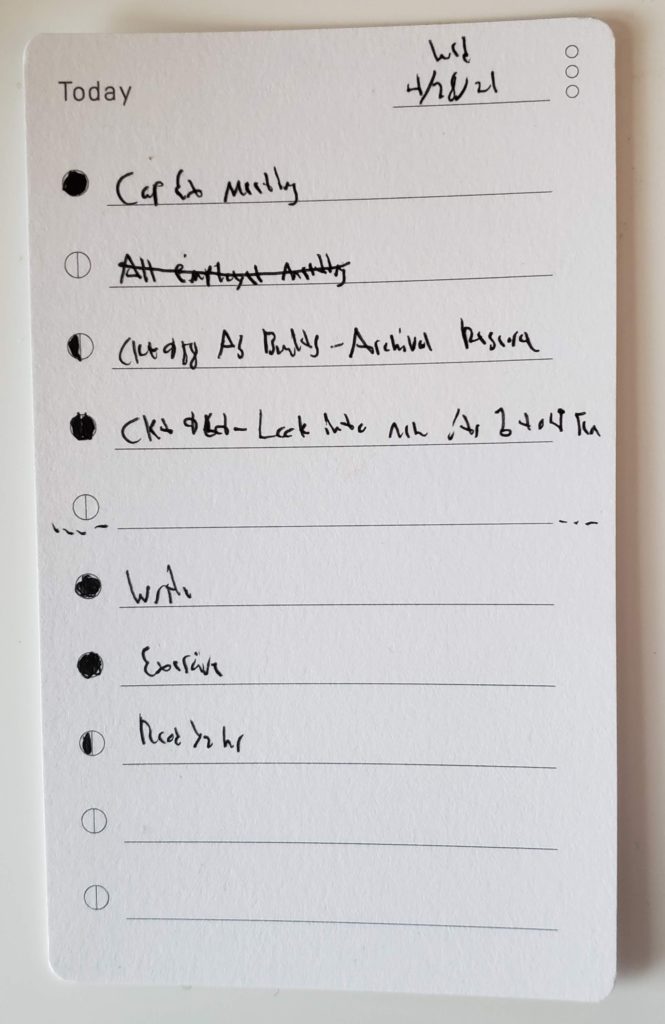
And now we have reached the end of our journey, the journey that took us from the highest aspirations laid out within Notion, to the hit list of tasks in Todoist all the way down to the triage that is Analog. Each of these tools has their own purpose in my daily life, and each of them is tailored to fit me in different ways. I hope you walk away from this post with inspiration for your own daily drivers. All great plans begin with aspirations and goals, but only once you break them down into specific tasks and pick the ones that mean the most to you can you actually achieve those goals.
References
| ↑1 | The unofficial name of Notion users out there. |
|---|---|
| ↑2 | Warning: Notion YouTube is extremely addicting and can lead to symptoms such as a perpetual desire to redo your set up. |
| ↑3 | More on that in my past post on my monthly review. |
